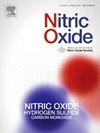Trial of the cerebral perfusion response to sodium nitrite infusion in patients with acute subarachnoid haemorrhage using arterial spin labelling MRI
IF 3.2
2区 生物学
Q2 BIOCHEMISTRY & MOLECULAR BIOLOGY
引用次数: 0
Abstract
Aneurysmal subarachnoid haemorrhage (SAH) is a devastating subset of stroke. One of the major determinants of outcome is an evolving multifactorial injury occurring in the first 72 hours, known as early brain injury. Reduced nitric oxide (NO) bioavailability and an associated disruption to cerebral perfusion is believed to play an important role in this process. We sought to explore this relationship, by examining the effect on cerebral perfusion of the in vivo manipulation of NO levels using an exogenous NO donor (sodium nitrite).
We performed a double blind placebo controlled randomised experimental medicine study of the cerebral perfusion response to sodium nitrite infusion during the early brain injury period in 15 low grade (World Federation of Neurosurgeons grade 1–2) SAH patients. Patients were randomly assigned to receive sodium nitrite at 10 mcg/kg/min or saline placebo. Assessment occurred following endovascular aneurysm occlusion, mean time after ictus 66h (range 34–90h). Cerebral perfusion was quantified before infusion commencement and after 3 hours, using multi-post labelling delay (multi-PLD) vessel encoded pseudocontinuous arterial spin labelling (VEPCASL) magnetic resonance imaging (MRI).
Administration of sodium nitrite was associated with a significant increase in average grey matter cerebral perfusion. Group level voxelwise analysis identified that increased perfusion occurred within regions of the brain known to exhibit enhanced vulnerability to injury. These findings highlight the role of impaired NO bioavailability in the pathophysiology of early brain injury.
使用动脉自旋标记磁共振成像技术对急性蛛网膜下腔出血患者的亚硝酸钠灌注脑灌注反应进行试验。
动脉瘤性蛛网膜下腔出血(SAH)是中风的一个破坏性分支。预后的主要决定因素之一是在最初 72 小时内发生的不断演变的多因素损伤,即早期脑损伤。一氧化氮(NO)生物利用率的降低以及与之相关的脑灌注破坏被认为在这一过程中起着重要作用。我们试图通过研究使用外源性一氧化氮供体(亚硝酸钠)在体内操纵一氧化氮水平对脑灌注的影响来探索这种关系。我们对 15 名低度(世界神经外科医师联合会 1-2 级)SAH 患者进行了一项双盲安慰剂对照随机实验医学研究,探讨了在脑损伤早期输注亚硝酸钠对脑灌注的影响。患者被随机分配接受亚硝酸钠(10微克/千克/分钟)或生理盐水安慰剂。评估在血管内动脉瘤闭塞后进行,平均时间为发病后 66 小时(34-90 小时不等)。在输注开始前和3小时后,使用多标记延迟(multi-PLD)血管编码伪连续动脉自旋标记(VEPCASL)磁共振成像(MRI)对脑灌注进行量化。服用亚硝酸钠可显著增加平均灰质脑灌注。组级体素分析表明,灌注增加发生在已知易受伤的大脑区域。这些发现凸显了氮氧化物生物利用率受损在早期脑损伤病理生理学中的作用。
本文章由计算机程序翻译,如有差异,请以英文原文为准。
求助全文
约1分钟内获得全文
求助全文
来源期刊

Nitric oxide : biology and chemistry
生物-生化与分子生物学
CiteScore
7.50
自引率
7.70%
发文量
74
审稿时长
52 days
期刊介绍:
Nitric Oxide includes original research, methodology papers and reviews relating to nitric oxide and other gasotransmitters such as hydrogen sulfide and carbon monoxide. Special emphasis is placed on the biological chemistry, physiology, pharmacology, enzymology and pathological significance of these molecules in human health and disease. The journal also accepts manuscripts relating to plant and microbial studies involving these molecules.
 求助内容:
求助内容: 应助结果提醒方式:
应助结果提醒方式:


